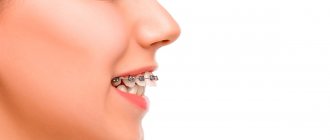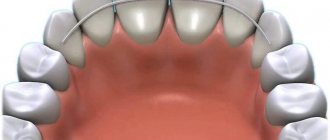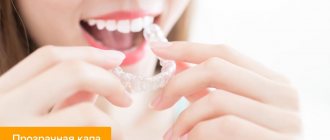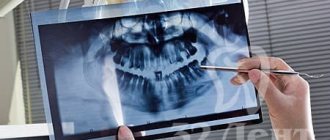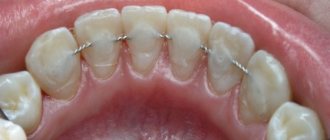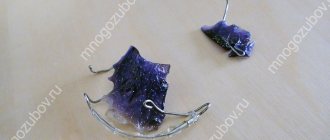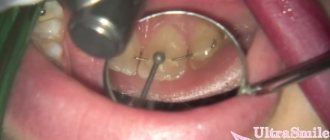Braces are special plates that are attached to the teeth to correct the bite. The plates are connected to each other by an arc, which, due to its elasticity, tends to take the correct position, puts pressure on the braces, and they, in turn, distribute the pressure on the teeth. Due to constant pressure, the bone tissue behind the tooth gradually decreases, the tooth moves to a new place and is fixed there. As a result, the bite becomes correct.
Most often, braces are installed in childhood, at 12–13 years old, when the jaw is still actively growing and more susceptible to changes. However, this does not mean that bite correction is only possible at this age - braces can also be installed on an adult. True, the treatment process in this case will have several features.
Indications for installing braces
As in childhood, in adulthood the only indication for installing braces is malocclusion. This anomaly is characterized by the following symptoms:
- Noticeable crowding of teeth, their creeping onto each other.
- Gaps between teeth.
- Teeth tilted back or forward.
- Excessive protrusion of one of the jaws forward or backward.
- Large distance between the teeth of the upper and lower jaw.
- Shift of the jaws or dentition laterally relative to each other.
These problems can be either noticeable even to the naked eye or hidden. Sometimes, at first glance, it seems to a person that everything is fine with his bite, although in fact there is a violation. In this case, only a dentist can recognize them during a professional examination.
Why is it important to choose the right orthodontist?
Orthodontic treatment is long-term, it will last from a year or more, so the patient cannot immediately determine whether it is being treated well or not. If something in the treatment goes wrong due to the doctor’s fault, you will find out about it months, or maybe years, later. In order not to waste time, money, nerves and health, it is important to immediately choose a good orthodontist with whom you will also enjoy communicating for a long time. If you want to know our recommendations on how to do this so as not to regret it, read the article: “How and why to choose an orthodontist?”
Why do you need to get braces?
Braces for an adult
Typically, braces are installed to improve your appearance. But sometimes malocclusions are almost invisible, so patients do not seek to correct them. But in fact, even a slight malocclusion can lead to serious consequences:
- Caries, gingivitis and other problems with teeth and gums due to uneven distribution of chewing load and injury to soft tissues from improperly growing teeth.
- Pain in the head and jaw due to improper positioning of teeth, compression of joints and nerves.
- Insufficient hygiene due to the fact that certain areas of the teeth cannot be approached due to other dental units.
- Rapid wear of individual teeth, abrasion and even loss.
- Digestive problems due to insufficient chewing of food.
- Inconvenience when using prosthetics in the future.
Therefore, even if there is no desire to make a smile beautiful, or if the bite does not spoil the appearance too much, treatment with braces is still necessary, since it is beneficial for health in the long term.
Nose
In patients with a reduced distance between the nose and upper lip and teeth protruding forward, the tip of the nose often noticeably drops down, giving the face a dull appearance, and the lip, on the contrary, protrudes upward. This occurs due to excessive tension in the muscles of the upper lip, which drags the skin along with it. Rhinoplasty is not needed in this case. After treatment with braces, the nose will rise slightly upward, and its owner will probably begin to receive compliments regarding her changed appearance.
Features of bite correction in adults
The rumor that only children can have braces did not appear out of nowhere. Indeed, by about 16–18 years, a person’s jaw stops actively growing, and his bones lose pliability. And if in childhood only a little pressure is enough to correct the bite, in adulthood everything is much more complicated:
- Correcting even minor defects requires at least a year, and sometimes treatment extends for 2–3 years.
- If there is no room for teeth, the jaw cannot be expanded; some teeth will have to be removed to create space for the rest.
- If the jaw is missing teeth or has dentures, this may complicate treatment and require the installation of special structures.
- After treatment, the teeth will tend to return to their original places, so it will take a long time to consolidate the results of the correction.
All this complicates the process, but does not mean that it is completely impossible to correct the bite in adulthood. Adults can wear braces, and although the treatment will be longer and more complex, it will still produce results and remain completely effective.
Bite correction: how long does it take?
Already at the beginning of treatment, the orthodontist will tell you how long you need to wear braces - the real and maximum period of correction. The average is 1.5-2.5 years. Treatment time depends on a number of factors:
- Age of the patient - for accelerated correction, braces are placed immediately after the appearance of the main teeth of the permanent dentition.
- Bite pathology - the difficulty of correcting anomalies in the dentofacial rows directly affects the duration of treatment.
- The type and material of the orthodontic apparatus - treatment takes place differently on lingual and vestibular braces, on bracket systems made of medical sapphires, ceramics, and metal.
Metal braces
Metal braces
The most common type of braces is metal. Both the braces themselves and the arch are made of a special medical alloy, safe and hypoallergenic. The composition of the alloy may vary depending on the brand of braces.
Modern metal braces are noticeably different from those that were common in Soviet times. They are not so huge and ugly, quite compact, less damaging to soft tissues and look good in the mouth. Many public figures and even stars are not shy about appearing in public with such braces.
Advantages
- Lower cost compared to other braces models.
- Wide range of models - manufacturers offer braces of different designs, depending on malocclusions and the wishes of the client.
- High strength - braces are much less likely to break and can cope with even serious malocclusions.
- Easier maintenance - you will still need a special brush for cleaning, but other systems take much longer to maintain.
- Easy to install - metal braces can be installed in almost any clinic, even in state dentistry under the insurance policy.
Flaws
- They are significantly inferior to other designs in terms of aesthetics and are much more noticeable on the teeth.
- While wearing it, a metallic taste is felt and the taste of food is distorted.
- Even modern metal braces cause allergies in some people.
- Metal braces still slightly injure the tongue, gums and cheeks; they often have to be sealed with special wax.
What factors affect wearing time?
- 1. Age. Bone tissue and ligaments in adolescents are more plastic, so eliminating bite problems of any complexity before the age of 18 requires an average of 3-6 months less time. This does not mean that complex defects cannot be corrected for an adult, but more time will have to be spent.
- 2. Complexity of the defect. The severity of the anomaly and its type also affect the timing of treatment. Even the most advanced cases of crowding are corrected faster than problems with jaw closure.
- 3. Type of system. The material and design of braces affect the timing. Non-ligature metal structures are the fastest to correct. Lingual ones take the longest, but they are invisible.
- 4. Doctor's experience. Optimal selection of the system, correct installation, control of tooth displacement - parameters that depend on the experience of the orthodontist. In our clinic, doctors are constantly improving their skills, so they can correct your bite in a minimum amount of time.
- 5. Patient compliance with recommendations. Following a diet and proper care of systems are also important. Damage to structures and the development of caries can cause a suspension of correction or a decrease in the effectiveness of treatment.
Ceramic braces
Ceramic braces
For adults, aesthetics is usually more important than for children - they need to appear in public more often and make a good impression. Therefore, ceramic braces are very popular among adults. Their arch is also made of metal, but the clasps are made of special medical ceramics.
Ceramics has a color that is as close as possible to tooth enamel. Thanks to this, braces are much less noticeable on the teeth. The metal arch is still noticeable, but it can be covered with white paint - then if people do not specifically look into your mouth, they will not even notice the braces.
Advantages
- Very high aesthetics.
- Greater hypoallergenicity - ceramics are a more biocompatible material, so they rarely provoke allergies.
- No unpleasant metallic taste in the mouth.
- Less trauma to soft tissues.
Flaws
- Slightly more brittle, which increases the risk of breakage, and also makes it difficult for braces to cope with some serious malocclusions.
- A little more complex care to ensure complete cleaning and maintain aesthetics.
- Some visibility - upon careful inspection, the braces are still visible.
- Difficult to install - such braces are unlikely to be installed in municipal dentistry, and they are not always found in private clinics.
In addition, ceramic braces are slightly more expensive than metal braces, although they are cheaper than many other types of braces. So this is a small drawback, but only relative to metal braces.
In general, if you are looking for a compromise between aesthetics and price, then ceramic braces are the best option.
Sapphire braces
Sapphire braces
Another type of aesthetic braces is sapphire. They are made from a special artificially grown sapphire that is transparent, crystalline and sparkling. Its properties are close to natural sapphire, it is highly durable and does not cause allergies at all.
Sapphire braces are similar to ceramic braces in many ways, but they have a significant difference. In certain lighting, they are much more visible on the teeth, as the light is reflected in the edges of the artificial crystals. At the same time, such visibility looks beautiful, turning braces from an ordinary device for correcting the bite into an elegant decoration.
There is no point in considering their advantages and disadvantages separately - they are almost completely identical to ceramic ones, except that they cost a little more, but at the same time they look more prestigious. In addition, not every clinic has the opportunity to install sapphire braces - metal and ceramic are much more common.
How long do you wear braces made from different materials on average?
Initial appointments with an orthodontist are devoted to many questions: how long should a teenager wear braces and how to care for them, which system to choose and which material is preferable. At this stage, doctors immediately clarify the dependence of the duration of treatment on the material and type of bracket system:
- Metal braces. The main advantage of the metal structure is the creation of optimal pressure on the teeth. This feature guarantees the correction of even the most severe malocclusions. The average time for bite correction is 12-18 months.
- Plastic braces. They have minimal strength and the lowest cost. The duration of treatment is significant, but since the design is used to eliminate minor anomalies, patients wear polymer braces for 1-1.5 years.
- Ceramic braces. The system consists of ceramic plates in the color of enamel and a metal arc. The design is aesthetically pleasing, but fragile and does not provide the necessary pressure on pathologically located units. Not suitable for correcting serious defects. The period of wearing ceramic braces is up to 3 years.
- Sapphire braces. They have an aesthetic design, are unnoticeable, and functional. They eliminate not the most complex bite defects. The course of treatment is up to 3 years.
- Lingual braces. The design involves fixation on the inside of the teeth, which allows the use of metal without compromising aesthetics. Effective, discreet - suitable for children and adult patients. The correction period is moderate - up to 2.5 years.
Rodikova Tatyana
Teenage patients pay increased attention to aesthetics, which is why they choose ceramic braces. Metal ones are also popular, especially due to the ability to put colored rubber bands and thus express oneself.
Comparison of brace systems by duration of wearing
It is difficult to estimate the duration of wearing braces in absolute numbers. Doctors recommend systems taking into account the patient’s age and the complexity of the pathology - they select designs with a moderate duration of wear. But if you choose similar solutions to eliminate the same defect, where the duration of the correction will be shorter:
- Material. Metal is the preferred option and guarantees quick correction. In second place are ceramics, then sapphire braces and plastic ones.
- Place of fixation. Lingual braces are more effective than vestibular braces, but the latter are more comfortable to wear and more affordable.
- Ligature or self-ligating - from vestibular brace systems. Elastic ligatures help set the vector of maximum impact and provide the best point pressure on a tooth or a specific area. This strategy shortens treatment.
Combined braces
Combined braces
When smiling, only the front teeth are visible, and only the upper ones are most noticeable. Therefore, it is not always necessary to place ceramic or sapphire structures on all teeth. To save money, you can install combined braces: put metal on some teeth, and ceramic or sapphire on others. Most often, for the greatest savings, aesthetic braces are placed only on the upper front teeth, although, if desired, you can also install ceramics or sapphire on the lower jaw.
Advantages
- Higher aesthetics compared to all-metal braces.
- Lower cost compared to sapphire or ceramic braces.
- Greater efficiency and versatility than ceramic braces.
- Greater strength - usually high loads fall on the chewing teeth, and the metal braces installed here cope better with them.
Flaws
- Slightly less aesthetics than braces made entirely of ceramic or sapphire - sometimes the structures are still visible when smiling or talking.
- Higher cost compared to metal braces.
- Low effectiveness for severe malocclusions, especially in the smile area.
- Difficult to install - only a highly qualified dentist can correctly install the combined system.
How to speed up treatment with braces
All patients can delay the time of braces removal. To do this, you must comply with the requirements of the pediatric orthodontist:
- Come to scheduled appointments. An appointment is more than just an examination. When communicating with the patient, the doctor evaluates the dynamics, changes ligatures and arches, and selects elastics for enhanced correction.
- Monitor the integrity of the system. If the ligatures break, the bracket comes off, or the orthodontic arch falls out, the patient needs to urgently consult a doctor to restore the structure.
- Change elastics according to schedule. At a certain stage of correction, the orthodontist strengthens the work of braces with the help of elastic bands. At home, the patient must change elastics every 12 hours - independently and without skipping.
Wearing braces is an effective way to correct the position of teeth and bite characteristics. Following the orthodontist's recommendations will help you get rid of crooked teeth, protruding or receding jaws - make your teeth straight and beautiful.
Lingual braces
Lingual braces
All of the above braces are installed as standard on the front surface of the teeth. Because of this, even aesthetic braces are still noticeable under certain lighting and close inspection. These braces are called vestibular braces.
But there are also lingual braces. They are made of metal, but are attached not to the front, but to the back surface of the teeth, on the side of the tongue. Initially, they were designed for a specific purpose - thanks to the pressure from the inside, such braces did a good job of pushing the jaw forward. But then they began to be used for various malocclusions, since in terms of aesthetics, lingual braces are superior to all other types.
Advantages
- Complete aesthetics - braces are completely invisible on the teeth.
- Highly effective for certain malocclusions.
- Durability like metal braces.
Flaws
- The highest cost - they are even more expensive than sapphire braces.
- More complex care: Cleaning braces on the back of your teeth is not easy.
- Complex and lengthy installation - only a very experienced dentist can carry it out, and the process itself takes more time.
- Ineffective for certain malocclusions - Sometimes lingual braces are simply not able to correct the malocclusion.
- Sometimes the tongue is injured and diction is impaired.
Lingual braces can also be used in combination with regular ones, for example, put them on the upper jaw, and classic ones on the lower jaw.
The principle of operation of the braces system
So, how do dental braces work? The main corrective link is the orthodontic arch. After X-ray diagnostics and determination of the ideal bite for a particular patient, the doctor makes calculations and selects an arch of the desired shape and cross-section.
During the correction process, the orthodontic arch tends to the shape specified by the orthodontist and pulls the parts fixed on it - locks, springs. And since the bracket is attached to each tooth, the teeth also move.
To maintain the strength and functionality of the structure, the doctor periodically replaces the weakened arch with a new one. In the first stages, the thinnest wire is used, gradually increasing the thickness.
Which braces to choose
As you can see, there are a lot of braces. True, you will need to choose between them not on your own, but together with the doctor, since the choice depends not only on the wishes of the patient, but also on the condition of the dental system. For example, quite often a patient would like to have aesthetic braces, but only metal braces can cope with his anomaly.
If you have a choice, then it is best to put:
- Metal braces, if there are no special requirements for aesthetics and there is a desire to save money.
- Ceramic, if you want not to spend too much on treatment, but at the same time maintain aesthetics.
- Sapphire, if there is a desire on the contrary, draw attention to your teeth and decorate them with “jewels”.
- Combined braces, if you are willing to sacrifice a little aesthetics for the sake of saving.
- Lingual, if you need maximum aesthetics.
Judging by the reviews, metal braces are still the most popular among adults, and many people are now calmly undergoing treatment with such structures, without facing the condemnation of others. Of the aesthetic designs, ceramic braces are the most popular, as they are quite inconspicuous, but not too expensive.
Why do braces change your appearance?
Not everyone knows that dental problems deform the face, adding asymmetry to it. Missing and long-term non-renewable teeth, malocclusion and periodontal diseases disrupt chewing function and overload individual teeth and facial muscles.
Aesthetic sapphire and ceramic braces, systematically correcting defects, strengthen the soft tissue framework, which includes skin, subcutaneous fat and muscles. Teeth moving into correct positions changes the position of the jaws and joints. As a result, muscles and ligaments are loaded evenly, sagging skin is tightened, and the fat underneath is redistributed.
Therefore, in parallel with the correction of dental anomalies, the shape of the face also changes. The degree of severity of the correction is determined by the individual characteristics of the dental system. But the accumulated experience and numerous photos before and after braces allowed specialists to formulate the general principles of the changes taking place.
How to install braces for adults
The installation of braces follows the same scheme, regardless of the chosen system. It all starts with preparation, which takes place in several stages:
- The dentist talks with the patient, examines his teeth, and listens to his expectations from treatment.
- X-rays, computed tomography are done, and if necessary, an impression is taken. Based on this, the treatment is simulated on a computer.
- A decision is made on the material of braces based on the examination and the wishes of the patient.
- Sanitation of the oral cavity is carried out - all diseases of the gums and teeth are treated, so that in the future there will be no need to carry out treatment and remove braces for this. Professional cleaning is also required.
- If it is necessary to create free space in the jaw, individual teeth are removed - usually chewing molars.
After the teeth are completely prepared, the braces are installed directly. It goes according to the following scheme:
- The teeth are thoroughly cleaned of plaque and dried of saliva.
- The enamel is etched with a special acid. It is safe, but makes the enamel more susceptible to the adhesive.
- A small amount of adhesive glue is applied to the enamel. Some modern braces have an adhesive on the clasps themselves - in this case this step is skipped.
- Braces are attached to the teeth one at a time.
- Excess adhesive is removed so as not to create voids under the braces, and then hardens under the influence of a special lamp.
- An archwire is threaded into the braces.
At this point, the installation is considered complete, the patient is taught how to care for braces, the next follow-up appointment is scheduled, and he is sent home. The whole process takes about half an hour; in the case of lingual braces, it can take an hour.
After installation, the patient will need to visit the doctor several more times to monitor the correction of the bite and replace the arch with a less flexible one.
Changes in appearance: minus to minus gives a plus
On numerous forums you can find negative feedback about the ongoing changes in the face: “the cheeks are sunken”, “the skin is sagging”, “the face has aged”, etc. As a rule, such reviews are typical for the first two months of treatment with vestibular and lingual braces. Negative consequences are indeed observed during this period. And they are caused by two reasons:
- removal of teeth that interfere with the correction of the dentition;
- installation of a sufficiently voluminous orthodontic system that has a certain weight, immediately changing the appearance visually.
As a result, in the first weeks of treatment, many women panic because they:
- the face narrows;
- nasolabial folds deepen;
- if the upper jaw becomes heavier, the chin becomes sharper, and if the lower jaw becomes heavier, the cheeks become sunken;
- With some pathologies, the lips begin to bulge and it becomes difficult to close them.
Fortunately, the negative consequences will go away very quickly with the beginning of visible treatment progress. And already in the third or fourth month, facial features will begin to change for the better. Let's take a closer look at this process.
How to care for braces
Braces care
While wearing braces, you need to follow a lot of rules. This is necessary so that the treatment goes well, and after removing the braces, the patient does not experience caries or other dental problems.
The main thing in care is to follow six basic rules:
- Visit the dentist regularly to monitor the treatment process, professional cleaning, and replacement of structural elements. Visits are scheduled by the doctor himself, usually once every one to two months.
- Brush or at least rinse your teeth after every meal. Even if you snack on a sandwich, you need to find a way to immediately rinse your mouth to remove any leftover food. Otherwise, they can penetrate under the braces and quickly cause the destruction of the enamel.
- Use special devices for cleaning - brushes and irrigators. We will talk about them in more detail below.
- Thoroughly brush your teeth on all sides and do it correctly. Often people brush their teeth only from the outside, which leads to the formation of plaque and stone, which can cause inflammation and caries.
- Consult a doctor in case of any breakdowns of the brace system; do not try to glue braces or insert an arch on your own.
- Before brushing your teeth, you need to remove all the rubber bands and rods that are attached to the teeth to move the jaws relative to each other.
In addition to a regular brush, special tools and devices will be required to care for teeth with braces.
V-shaped toothbrushes
They are considered one of the most effective devices for cleaning teeth with braces. They differ from ordinary brushes in that in the center the bristles are shorter than at the edges, that is, a special recess is formed, just for braces. When cleaning, a regular brush simply glides over the braces and practically does not touch the enamel, but this one allows you to clean everything as thoroughly as possible.
In addition, short bristles clean locks better, and long bristles are good at cleaning out food debris from between teeth.
This brush can be used instead of a regular brush for regular cleaning. Teeth should be treated with sweeping movements, locks should be cleaned vertically, and the brush should only be moved from the gums to the edge of the teeth. The arc should also be cleaned, but only horizontally.
When brushing, you must use toothpaste, you can use regular toothpaste, preferably containing fluoride.
Mono-beam brushes
Regular brushes have many tufts of bristles on the head, while mono-tuft brushes have only one. The shape of this beam can be cut or slightly pointed. This bundle is not suitable for regular cleaning, but it does a good job of removing plaque between teeth.
When brushing, keep the brush at a 90-degree angle to your teeth. First you need to go in the gum area, then between the teeth, and then move on to cleaning the locks in a circular manner. This brush can be used not every time, but once a day or two.
Cleaners
Such designs are a small handle with nylon bristles. Brushes can be of different lengths, thicknesses and shapes - they need to be selected depending on which one is more convenient for the patient to use. You need brushes to clean the space under the arches and near the clasps. Brushes cannot be used regularly, but only if something gets under the braces.
Irrigators
An irrigator is a special device that delivers a stream of water under high pressure to the teeth. In general, it can be used without braces, but during orthodontic treatment it additionally helps to completely remove plaque. At the same time, the irrigator massages the gums, which prevents their inflammation.
You need to use the irrigator several times a week, after basic teeth cleaning.
Why do you need rubber bands for braces?
The basis of bite correction systems is an orthodontic arch, which, through the locking part of the structure, creates programmable pressure on the crowns of the teeth. In cases where the traction of the arc needs to be strengthened, special elastic bands for braces are additionally used. Their particularly strong and elastic structure creates additional pressure on the problem area, and the final result directly depends on the point of application of the forces.
There are several types of rubber bands:
- Ligatures are part of the structure of ligature bracket systems of the same name. They play the role of fastening elements between the dental plates and the arch itself.
- Chains – used to create additional tension when correcting interdental spaces (threes and diastemas). To do this, individual rings of the chain are attached to the dental plates of adjacent teeth in the problem area to generate additional force that brings the crowns together.
- Pulls for braces - to form a tight closure of teeth when correcting the bite. They are attached to the crowns of different jaws to fix their correct alignment with each other.
Unlike ligatures and chains that the orthodontist installs, the patient will have to learn how to put on and remove them independently. They are not put on immediately, but 5–6 months after fixing the orthodontic arch and worn for at least 12 hours a day.
Nutrition during braces treatment
To prevent your braces from breaking during treatment and your teeth from getting sick, you need to eat right:
- Avoid any sticky or chewy food - chewing gum, toffee, nougat and caramel. All of these products can easily get stuck in the braces, move them, and break the entire system, which will disrupt the treatment process.
- Do not bite too hard foods: apples, carrots, crackers, nuts. Even a single bite can change the tension of the wires or lead to breakage of the bracket. Such products are not completely prohibited, but they need to be crushed.
- Do not eat hot food immediately after cold food and vice versa. Such sudden temperature changes not only damage the enamel, but can also cause the braces to strip, stretch and narrow its individual components.
- Try not to use products with dyes - they can change the color of the ceramic or sapphire braces.
- Limit carbohydrates—while wearing braces, they are difficult to clean completely and can cause tooth decay. This is especially true for sweets.
Call us and make an appointment!
Whatever models of braces are used, the result of bite correction directly depends on the qualifications and practical experience of the specialist. Since installing any system requires a thorough diagnosis and preliminary calculations, the professional skills of an orthodontist are extremely important. It is the specialist who determines the most effective method for correcting the anomaly, and also calculates the pressure with which the teeth should move.
Orthodontist Irina Aleksandrovna Butorina has extensive practical experience in the treatment of any malocclusion disorders and knows the most innovative correction methods. By making an appointment, you will be able to verify her competence from personal experience, and if you follow all the specialist’s recommendations, you will get an excellent result and a flawless smile.
Contact us and forget about complexes, inconveniences in communicating with others and possible health problems. Make an appointment and come see your bite corrected with braces for adults professionally!
Consolidation of treatment results in adults
After the braces are completely removed, the teeth are in the correct position, but are not yet secured in it. As a result, if nothing is done, they will quickly return to the original state to which they are already “accustomed”. Therefore, after correcting the bite, it is necessary to wear special structures - retainers. And the period of wearing them is called retention.
There are two main types of retainers—removable and permanent. Removable ones are also different:
- Records. They are made by hand in a laboratory, which poses the risk of human error and bias. This can cause the teeth to move slightly during retention. But such plates are inexpensive and can be easily produced in almost any clinic.
- Mouthguards. They are stamped on a special machine, which allows them to be manufactured as accurately as possible and eliminate the influence of the human factor.
Removable structures are quite comfortable, unnoticeable, and can be removed while eating and brushing your teeth. However, they also have a drawback - the removable design is easy to remove and then forget to put on. The result is the same - the teeth will return to their original places, and you will have to repeat the long and expensive treatment with braces.
Fixed retainers are splints made of special wire that are secured to the back of the teeth with cement. They are convenient because they are easy to wear all the time, but they make hygiene somewhat difficult. Additionally, these fixed structures cannot keep the teeth from moving completely, so they may end up shifting slightly. And the last drawback is that a permanent retainer can only be placed on the lower teeth.
Therefore, dentists more often recommend wearing special removable mouth guards, since they keep teeth from moving much more reliably.
The retention period is quite long - one and a half to two times longer than treatment. That is, if you wore braces for two years, you will have to wear retainers for another three to four years. But this is necessary, otherwise the teeth will shift and eventually the treatment with braces, and then the retention period, will have to be repeated.
How long do teenagers wear braces?
The standard age for installing braces is 12-17 years. The physiology of the child’s body makes the speed of bite correction faster and the treatment more effective. The following factors contribute to reducing the period of wearing braces:
- complete change of bite;
- eruption of second molars;
- the end of the formation of the dental system and the muscular-ligamentous apparatus while maintaining their good mobility.
The bone tissue of adolescents is plastic and quickly responds to mechanical pressure, which allows teeth to be shifted to an anatomically correct position.
Soldatenkova Alina
I am often asked how long to wear braces for a 13-year-old teenager. The average time for bite correction is 1-1.5 years. But each case is individual.
Alternatives to braces treatment
Modern braces may be aesthetically pleasing, but they are still noticeable or not very comfortable - they impose many dietary restrictions, complicate oral hygiene, and damage soft tissues and enamel. Therefore, it is logical that you want to correct your bite without braces.
In adulthood, there are only two such methods.
Removable mouthguards
Special mouthguards made of transparent plastic. They are made individually from impressions and put pressure on the teeth in much the same way as the arch of braces. Mouthguards should be removed when eating or brushing teeth, and they do not have to be worn all day, for example, during public speaking. At the same time, the aligners themselves are also transparent and invisible - judging by the reviews, they are even less visible than ceramic or sapphire braces.
In general, mouthguards are much more convenient than braces, but they are only suitable for minor malocclusions, and are also expensive, about the same as lingual braces.
Veneers
Veneers are special ceramic shells that cover teeth. They are used if the front teeth are slightly crooked, but the anomaly is not serious, and you don’t want to get braces for it. Onlays can mask minor irregularities and gaps between the teeth, that is, they do not actually correct the bite, but make the smile perfect.
Alternative methods are more convenient, but for severe malocclusions, braces are still the only effective treatment.
Classic vestibular braces
They are also external braces - the most common. These braces are fixed on the outer surface of the teeth, the one we see when we smile.
Vestibular braces are the most popular system for correcting malocclusion, but they are not the only one, including for adults.
Ligature braces (the arch is secured with special rubber bands - ligatures)
Advantages of external braces in the treatment of malocclusion:
- This is the most functional device that we can use in adults. Corrects all possible malocclusions. If the case is complex and surgery is needed, braces are worn before or after it. In addition, they can be supplemented: install springs, rods, buttons, ligatures, chains for pulling out impacted teeth. The more complex the pathology, the greater the likelihood that something additional will need to be tightened, and this is where such a wide functionality of braces comes in handy.
Example: a spring connects the braces and forms the bite
- The second plus is a consequence of the first: braces provide the maximum effect of expanding the dentition. If the row is significantly narrowed compared to the norm, braces are most preferable. In addition, the narrowing of the dentition is most often accompanied by the absence of some teeth (that is, they are there, but are located inside the gums - they remain impacted). And pulling out impacted teeth using an arch of braces is justified and convenient.
- Price. You can choose to suit any budget. Expensive - transparent sapphire and for a relatively small amount - metal. Visually they are less attractive, but no worse in efficiency.
Aesthetic ceramic braces are less noticeable.
External braces also have disadvantages. Moreover, they are the same for any system, both the simplest metal one and the aesthetic one with white or transparent braces.
- Any external braces, even white-painted arches, are still noticeable. And this often influences the choice: not all adults are ready to wear them. Although no one is surprised by braces for a long time, and no one pays attention to them, for many it is still a psychological barrier.
- It is more difficult to maintain hygiene. Although adult patients usually take a conscious approach to treatment and follow all recommendations, force majeure nevertheless occurs: trips on vacation or a business trip, where there is no time or it is inconvenient to constantly brush your teeth after eating. Braces are a non-removable structure, you have to eat with them, and leftover food remains on them. You have to spend about 20 minutes on each brushing (about an hour a day in total), otherwise plaque will form, which increases the risk of developing caries. Braces themselves do not cause caries and do not spoil the enamel - plaque damage due to poor hygiene does.
- Wearing braces hurts. Although this is subjective, it all depends on the individual and pain threshold. In the first days after activation of the system (it is carried out every month), some patients sometimes have to take pain medication. In addition, the protruding parts of the braces can scratch the oral mucosa and rub it. For most patients, this goes away within a few days, while others experience discomfort from such side effects throughout the entire treatment period. But you can seal the protruding areas of the braces with orthodontic wax.
This is what braces with protective wax look like
- You are not allowed to eat all foods with braces, even after the pain subsides. Avoid solid foods - hard fruits and vegetables, nuts. Chewing meat also becomes difficult, as fibers become clogged in the space between the teeth and the arch. The fact that you will have to eat food pureed through a blender for a year is an exaggeration, but you can forget about some delicacies for a year and a half.
Braces are effective for treating adults, but you have to come to terms with the shortcomings of this technology. Spend a lot of time taking care of your teeth, limit yourself to certain dishes, get used to your smile with “decoration”.
